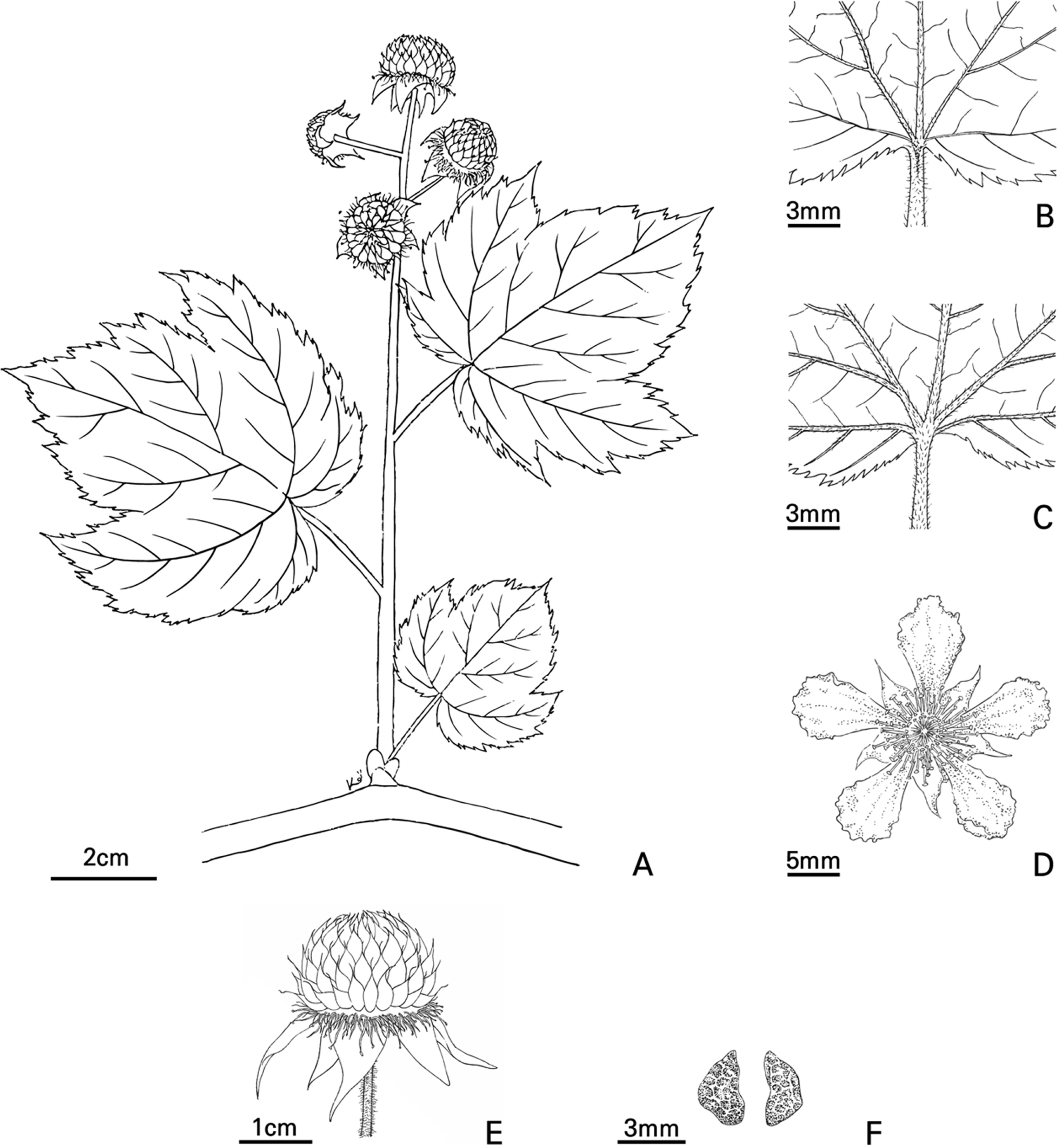/home/virtual/kjpt/journal//../xmls/kjpt-53-4-305.xml
HYUN, JUNG, and NA: A new variety of Rubus (Rosaceae): Rubus takesimensis var. flavus
Abstract
A new variety of Rubus, Rubus takesimensis Nakai var. flavus J. O. Hyun & B. T. Jang (Rosaceae), was discovered on Ulleungdo Island, Korea. This variety is different as it has yellow fruits and yellow-green branchlets and leaves compared to Rubus takesimensis var. takesimensis.
Keywords: endemic plant, new variety, Rubus takesimensis var. flavus
INTRODUCTION
Rubus L. is one of the largest genera in the family Rosaceae, consisting of around 700 species spread across the globe ( Lu and Boufford, 2003). Twenty species of Rubus are naturally distributed in Korea ( Park and Yang, 2007). Among them is R. takesimensis Nakai, an endemic plant that grows only on Korea’s Ulleungdo Island ( Sun et al., 2014; Chung et al., 2017). We have found a new variety of R. takesimensis with a different fruit color on Ulleungdo Island and formally describe here.
TAXONOMIC TREATMENT
Rubus takesimensis Nakai var. flavus J. O. Hyun & B. T. Jang, var. nov.—TYPE: KOREA. Gyeongsangbuk-do, Ulleung-gun, Seo-myeon, Namyang-ri, Mt. Byeoraksan, 19 Jun 2022, J.O. Hyun, B.T. Jang, K.S. Kang & Y.M. Kim s.n. (holotype: KB; isotype: KH, NNH, HIBR).
Korean name: No-rang-seom–na-mu-ttal-gi (노랑섬나무딸기).
Shrubs, deciduous, erect or spread, 1.0–2.5 m tall. Stems light yellowish green, glabrous, without prickles; young branches pubescent. Leaves simple, alternate; petiole 1.6– 3.1 cm long, pubescent, without prickles; blade palmately 3– 7 cleft, rounded or elliptical, 3.3–10.0 × 3.4–9.8 cm, base cordate, apex acute or acuminate, margin biserrate; adaxial surface light green, rarely pubescent, abaxial surface densely pubescent on main vein. Inflorescences corymbose on first year branch. Flowers bisexual, actinomorphic, 1.5–2.5 cm in diameter; pedicels 0.9–1.8 cm long, villous; sepals 5, spreading, becoming reflexed in fruit, long deltoid, 0.6–1.5 × 0.3–0.5 mm, pubescent; petals 5, white, elliptic, base clawed; stamens many; ovaries many, glabrous. Fruits aggregated drupelets, globose, 1.0–1.9 × 1.0–2.2 cm, ripening yellow, glabrous, separating from torus. Seeds elliptic, 1.0–1.3 × 2.0– 2.4 mm, light yellow, surface reticulate ( Figs. 1, 2).
Distribution: Ulleungdo Island, endemic to Korea.
Flowering and fruiting: May to June.
Etymology: Yong branchlets and leaves are light yellow-green and aggregate fruits ripening to yellow in color.
Habitat: A population of R. takesimensis var. flavus is found along roadside in a valley of Mt. Byeoraksan. The population area is 3 × 6 m², and the population consists of ten individuals. Ruvus takesimensis var. flavus grows with shrubs such as Albizia julibrissin Durazz. and Acer okamotoanum Nakai, and herbs such as Vitis coignetiae Pulliat ex Planch., Anthriscus sylvestris (L.) Hoffm., Dystaenia takesimana (Nakai) Kitag., and Miscanthus sinensis Andersson. In addition, R. takesimensis var. takesimensis grows around this plant.
Rubus takesimensis Nakai, which is endemic to Ulleungdo Island, is commonly found throughout the island. The plant is presumed to have evolved into a new species through anagenesis from Rubus crataegifolius Bunge, a closely related species, which entered Ulleungdo Island ( Sun et al., 2014; Lee et al., 2017). It appears that the leaves and flowers have become larger due to the abundant humidity, and stems and leaf spines have degenerated in an environment without predators. The new variety is distinguished from R. takesimensis var. takesimensis by its yellow fruits. Considering the limited distribution of the species, protection and careful measurement of its resource value are needed.
Key to Rubus takesimensis var. flavus and its related taxa in Korea
1. Stems and leaves with curved prickles ······························· ··············································· Rubus crataegifolius 산딸기 1. Stems and leaves without curved prickles or rarely with sparse minute prickles
2. Fruits ripen red, branchlets brown or reddish brown, leaves green ····································································· ············· R. takesimensis var. takesimensis 섬나무딸기 2. Fruits ripen yellow, branchlets light yellow-green, leaves yellow-green ···································································· ·············· R. takesimensis var. flavus 노랑섬나무딸기
ACKNOWLEDGMENTS
The authors are grateful to two anonymous reviewers who provided invaluable comments on the early version of the manuscript.
Fig. 1.
Photographs of Rubus takesimensis Nakai var. flavus J. O. Hyun & B. T. Jang. A. Holotype specimen. B. Habitat. C. Whole plant. D. Stem. E. Infructescence. F. Fruit comparison (left: R. takesimensis var. takesinensis, right: R. takesimensis. var. flavus). 
Fig. 2.
Illustration of Rubus takesimensis Nakai var. flavus J. O. Hyun & B. T. Jang. A. Plant. B. Adaxial surface of leaf. C. Abaxial surface of leaf. D. Flower. E. Infructescence. F. Seeds. 
LITERATURE CITED
Chung, G. Y. Chang, K. S. Chung, J.-M. Choi, H. J. Paik, W.-K and Hyun, J.-O. 2017. A checklist of endemic plants on the Korean Peninsula. Korean Journal of Plant Taxonomy 47: 264-288.   Lu, L and Boufford, D. E. 2003.
Rubus L. Flora of China. Vol. 9. Pittosporaceae through Connaraceae. Wu, Z. Y. Raven, P. H. Hong, D. Y (eds.), Science Press, Beijing and Missouri Botanical Garden Press, St. Louis, MO. 195 pp.
Lee, W. Yang, J. Jung, K.-S. Pak, J.-H. Maki, M and Kim, S.-C. 2017. Chloroplast DNA assessment of anagenetic speciation in Rubus takesimensis (Rosaceae) on Ulleung Island, Korea. Journal of Plant Biology 60: 163-174.   Park, J. H and Yang, J. Y. 2007.
Rubus L. The Genera of Vascular Plants of Korea. Park, C. W (ed.), Academy Publishing Co., Seoul. 558-559.
Sun, B.-Y. Shin, H. Hyun, J.-O. Kim, Y. D and Oh, S. H. 2014. Vascular Plant of Dokdo and Ulleungdo Islands in Korea. National Institute of Biological Resources, Incheon. 150 pp.
|
|













